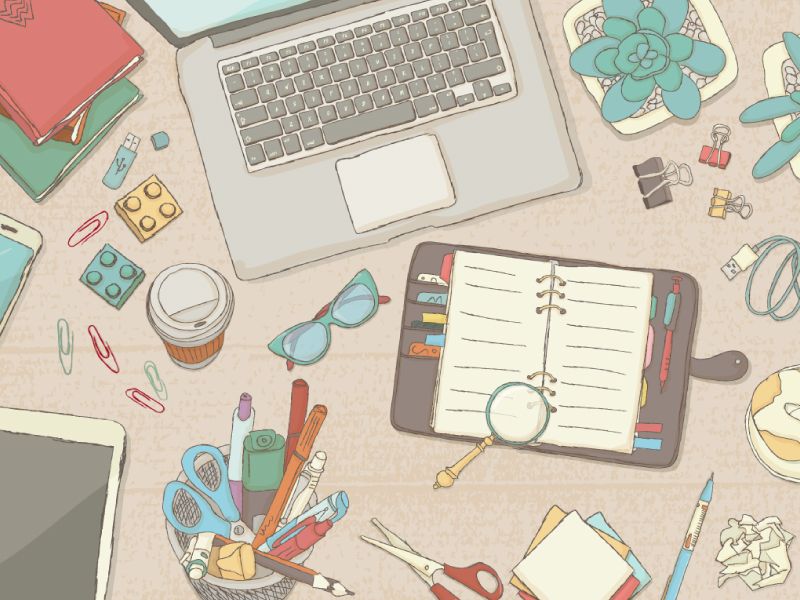Have you ever sat at your study desk and wondered: “Why is it so difficult for me to start studying?”
Distractions can be present in tangible forms, but unhelpful thoughts can fog our mind as well. While there is not one method that will work for everyone, it’s important to experiment with your study space and find the best environment for you!
The idea of studying can sound like an intensive task that requires a lot of commitment, especially if you’re stressed about an upcoming week where you have multiple midterms and proficiencies. To ease some of that stress, here are my personal tips to create your ideal study environment where comfort and productivity can mesh well together:
1. Minimize your distractors.
Before I set out any study materials, my first step is to clean up my desk area and remove anything that may be distracting to the eye. For example, I will hide my phone in my closet or in another area where I do not frequent it too often in my space. When my phone is way out of my reach, I feel less tempted to use it.
Another example of a distractor I can provide is the sounds you hear in a public space. I am an avid fan of coffee shops, but I also realized that the sound of espresso machines running and people conversing next to my table can be distracting. Once I invested in a great pair of noise-canceling headphones, I was able to maintain my focus for a longer time while enjoying the presence of people around me.
It’s important to identify your distractors and find solutions to minimize them so that you’re able to maximize the time you focus on your study materials. This is crucial for long studying sessions where your goal is to sit in one place for more than a few hours.
2. It’s OK to change the location.
I have found myself sitting in front of my desk at home, staring at the wall for so long without any tasks completed. Finding the motivation to change your study environment can be so difficult, especially if you’ve laid out all your study materials already. However, maintaining flexibility is key to being productive!
If you find yourself unable to focus in one environment, do not be afraid to change the location! There was one day where I hopped from my bedroom space, to the school’s library, and then to a public library. Depending on how spontaneous you are, this method might not work out for everyone! However, this could be helpful to experiment with if you are unsure of which study spaces are best for you to thrive in.
3. Find inspiration around you.
Studying does not have to be a dreadful task! On social media, there are many accounts that are solely dedicated to sharing study tips and pictures of their study space. I also recommend following accounts that upload posts of positive affirmations and inspiring quotes. Find any quote that resonates with you, write it down, and post it on your wall!
Whenever I am studying in a public space, such as the library, I like to gain inspiration from the people sitting around me by observing how they organize their space as well. There is inspiration around us everywhere, so find whatever it is that stands out to you and try it out for yourself!
4. Stand up and move around!
No matter how long your study session is, take a break (even if it is for just a minute stretch). When you are studying for long periods of time, it can become exhausting and physically straining on your back if you sit for too long.
There are many study timers online for you to take advantage of, but I personally don’t have a strict timer that I follow. While I am studying, I set small goals within the tasks I have to complete and check those off my list before I start my break. For example, if I am watching a lecture that is 2 hours long, I will set a goal to finish watching at least 1 hour of my lecture first and then take a 10 minute break to do chores. This way, you are breaking a more complicated task into simpler chunks.
5. Be mindful of your “study playlist” selection.
While this may not apply to students who focus best without music playing in the background, this tip is important to consider if you want to experiment with it! Music can help your thoughts flow and many of us can find comfort in it, but its effects can be counterproductive if we catch ourselves paying more attention to the song.
I personally like to listen to songs that are purely instrumental, so I won’t be focused on the lyrics too much. I love listening to genres like Bossa Nova, Jazz, and Classical while I am studying. There are also playlists on the internet that are dedicated to white noise (which sounds like rustling wind to me) or nature sounds.
6. Give yourself grace.
There is no perfect studying session I have ever had in my personal experience. The key thing to remember in building your ideal studying environment is to be patient with yourself. As you enter graduate school and progress, you’ll discover that everyone has their own way of studying including yourself.
As you experiment with building your ideal study environment, I hope that my personal guide can help ease any stress that you may have with either starting a task or maintaining your focus. I wish you the best of luck!

